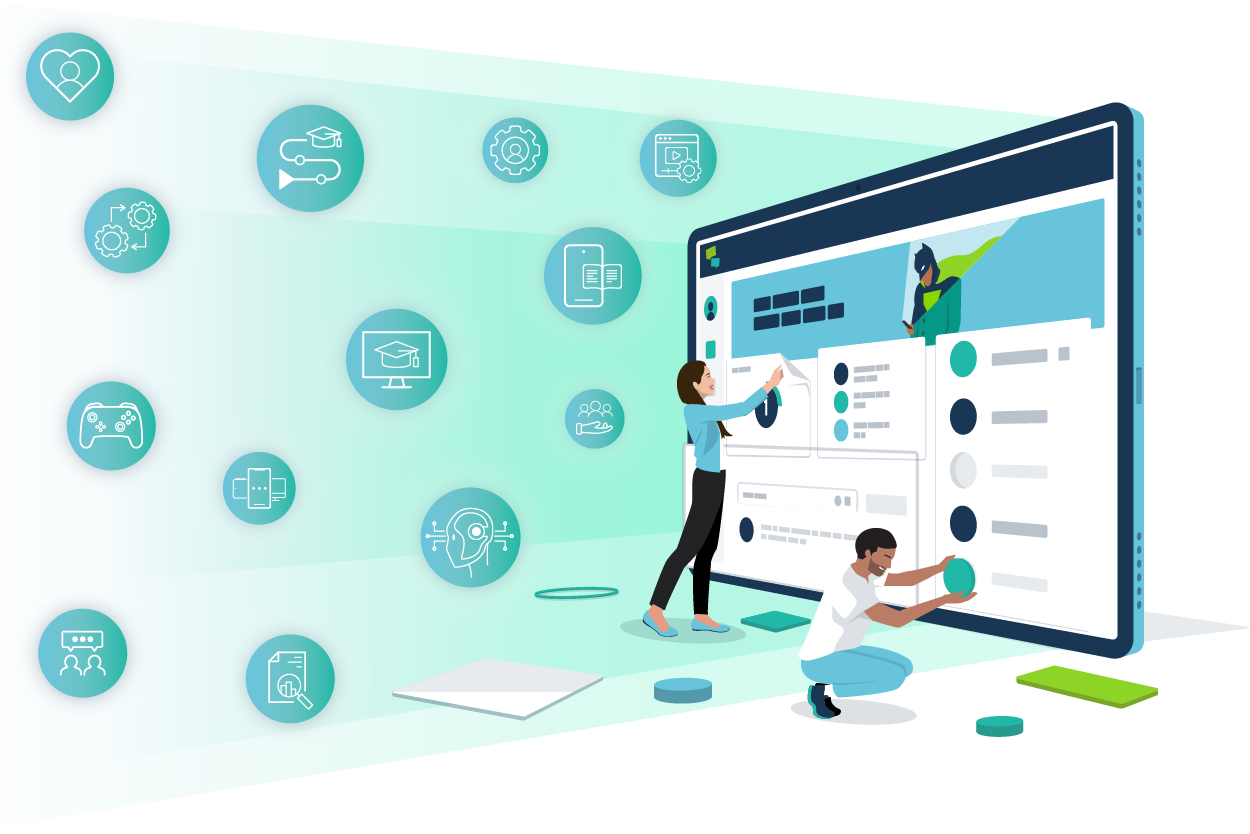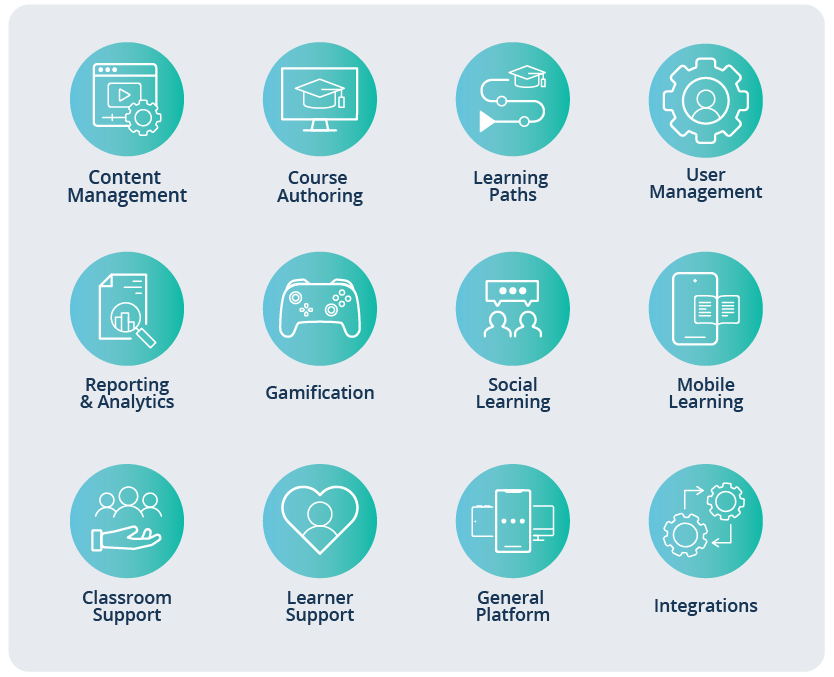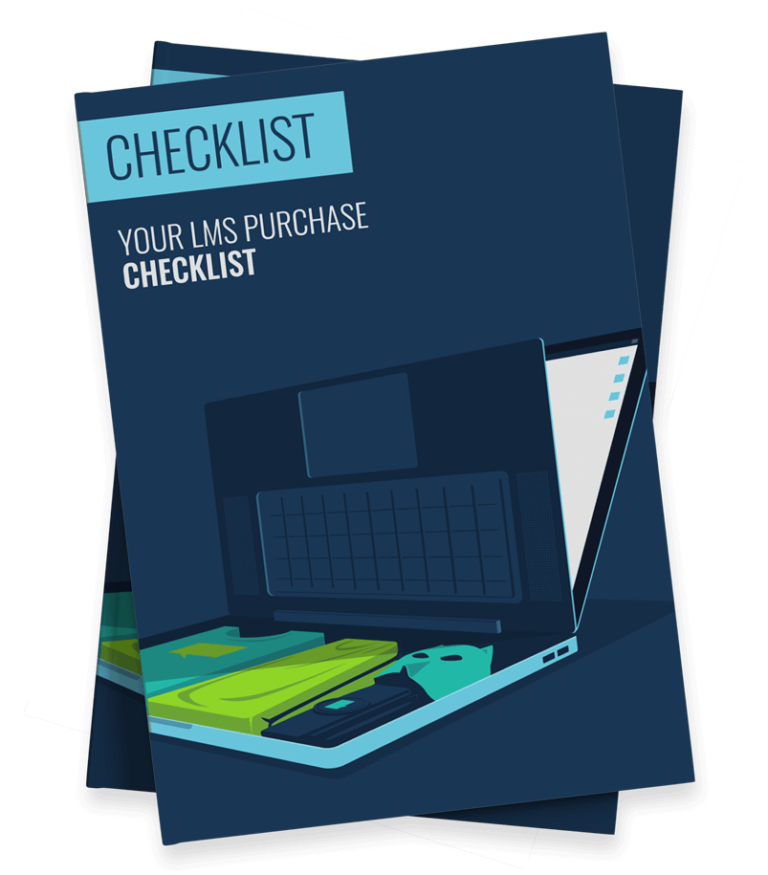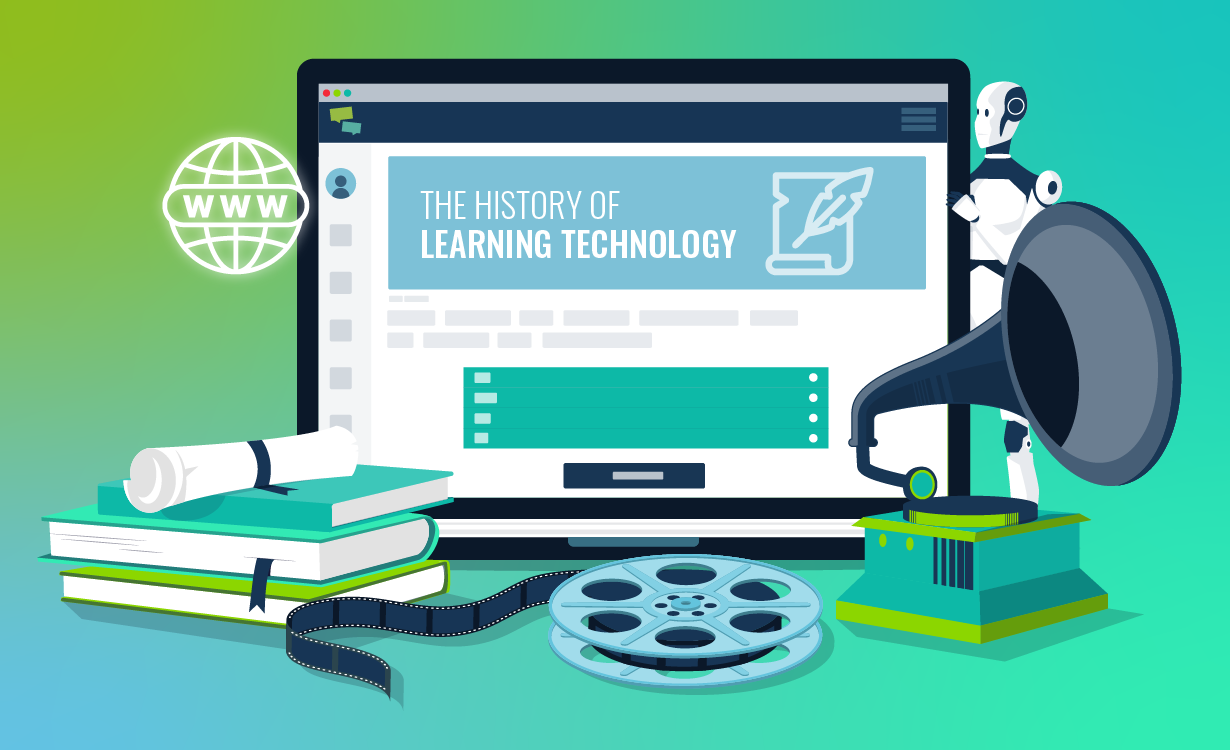
If your employees aren’t learning, then your organisation isn’t moving forward. This is why a learning management system (LMS) is no longer a luxury; it’s a business imperative. Indeed, without one, it’s very difficult to achieve your learning objectives.
But with countless LMS options available, each promising unique features and benefits, picking the right solution can seem daunting. Where do you start?
According to the Learning Guild, when it comes to purchase decisions, 81.9% of buyers prioritise functionality over both price and support services.
With this in mind, we’ve created a comprehensive list of 44 must-have LMS features. You can use this list to establish your priorities and help guide your selection process. But first, let’s start with a definition.
What is an LMS?
A learning management system (LMS) is a software platform that is used to create, manage, deliver, and track educational courses and training programmes. It’s a virtual learning environment that provides a centralised hub for both learners and instructors.
This makes it a powerhouse of online learning. It’s a versatile tool that can be used in various settings, from schools and universities to corporate training departments. Typically, it helps organisations to:
- Create Content: Create or upload a wide range of learning content, including text, videos, quizzes, eLearning, and more.
- Deliver Content: Share this content with your learners in a well-structured format, through a user-friendly interface.
- Track Progress: Gain valuable insights into learner progress through detailed tracking and assessment features.
- Generate Reports: Use reporting features to analyse your programme’s strengths, weaknesses, and areas for improvement.
And this is just the tip of the iceberg. As we progress through this article, you’ll see that LMSs also offer an array of features to engage learners, foster collaboration, personalise learning, meet compliance standards, and much more.
Want to dig further into this topic? We’ve got a full article on LMSs right here.
The Top 44 LMS Features
Now that we understand the basics of an LMS, let’s dive into the nitty-gritty: its features. To make things easier, we’ve categorised these features to help you navigate the wide range of different options available.

Content Management
1. Content Creation & Upload: What good is a learning system without any learning content? With an LMS, authorised users can create and upload a variety of content types. These materials can then be easily modified or organised to suit specific learning objectives.
Did you know: It takes an average of 197 hours to develop a 1-hour eLearning course.
2. Multimedia Support: With the right platform, the sky’s the limit when it comes to your learning content. Most LMSs support a wide range of media formats, enabling rich and engaging learning experiences. As a result, learners will be able to access videos, audio clips, images, eLearning, and more.
3. Content Organisation: Real libraries are meticulously organised so that books are easy to find. Your LMS library should reflect this ethos. Content can be structured into modules, units, or full curriculum, making it easier for learners to navigate. Your LMS should also provide features for tagging, categorising, and searching content.
Did you know: 94% of online learners prefer to study at their own pace.
Course Authoring
4. Built-in Authoring Tools: In order to create eLearning content, you’ll need access to an authoring tool. While there are numerous standalone options available, many modern LMS platforms come equipped with built-in authoring capabilities. For instance, Growth Engineering Authoring Tool helps you to create gamified training content in minutes.
Did you know: The authoring tool market is growing fast. It’s forecasted to rise at a compound annual growth rate of 14%, reaching $4.9 billion by 2036.
5. SCORM Compatibility: SCORM (Sharable Content Object Reference Model) is a standard for eLearning content. Most modern LMSs are SCORM compatible, which means that users can import (and track) courses created within other authoring tools. As a bonus, you’ll also be able to export your SCORM courses and reuse them on other compatible platforms.
Did you know: SCORM debuted all the way back in January 2000, and it remains the most popular eLearning standard.
6. Assessment Options: Learning management systems offer a variety of methods and tools for evaluating learner performance and knowledge retention. This includes (but is not limited to): quizzes, assessments, assignments, surveys, polls, and peer reviews. You may also be able to set time limits and grading criteria.
Did you know: Formative assessments can help to increase student satisfaction by 8.6%.
Learning Paths
7. Structured Learning Journeys: Learning’s a journey, not a destination. To create truly effective training experiences, you need to guide learners through a structured path. Thankfully, LMSs help you to define the exact sequence of courses and modules. For instance, our Levels and Curricula features provide this essential structure for your learners.
Did you know: Levels are a game mechanic. Gamification has been shown to improve learner engagement by as much as 60%.
8. Prerequisites & Dependencies: You can also control when learners access specific content. For example, you can set prerequisites, such as completing a previous module, or schedule content to release on specific dates. You can even configure content to release once an XP target has been achieved.
Did you know: Campaign learning is an excellent way of fighting back against the forgetting curve.
9. Certification: Once learners complete their pathway, they can be awarded a certificate (usually in a .PDF format) in recognition of their achievement. This feature is particularly useful for compliance training programmes, where certification can verify an employee’s knowledge of regulations.
Did you know: For every $1 invested in compliance training, you save $1.37 in potential fines, damages, and settlements.
User Management
10. Roles & Permissions: This feature allows administrators to define different user types (e.g. learner, manager, administrator) and assign specific permissions to each role. This ensures that each user can only access and perform actions relevant to their responsibilities. For instance:
- Admins: Have full access to all LMS features and settings.
- Managers: Manage user accounts within their specific department or team.
- Learners: Can only access content they have permission to view.
Did you know: 91% of managers agree that eLearning helps to close skill gaps within their team.
11. Learner Enrollment: Admins can add, edit, and remove learners from your LMS. But the fun doesn’t stop there. They can also enrol learners on specific courses, track their progress, and manage their account information. To save time and effort, many of these actions can be performed in bulk.
Did you know: An estimated 73.8 million people use a learning management system. That’s more than the entire population of the United Kingdom.
12. Group Management: Managing learners individually can be time-consuming. Content groups streamline this process by empowering you to organise learner access based on specific criteria (for instance, teams, departments, or roles). These groups also help to facilitate communication and collaboration.
Did you know: Social learning has been shown to improve course completion rates by as much as 85%.
Reporting & Analytics
13. Customisable Reports: Every LMS comes with a reporting suite, so you can evaluate the success of your training programme. This feature lets you generate tailored reports based on your specific needs. For instance, with a reporting suite, you can track:
- Logins
- Completion rates
- Time spent on content
- Assessment scores
- And much more
Did you know: 82% of L&D professionals say that reporting and analytics are important features on their LMS.
14. Data Visualisation: Running reports is one thing, understanding them is another. Thankfully, data visualisation tools transform raw data into easily understandable visual representations, such as graphs, charts, and dashboards. This makes it easier for you to identify the insights hidden within your learning data.
Did you know: Companies that use data visualisation are 5x more likely to make a timely decision.
15. Data Export: Once generated, reports can be scheduled to run automatically at regular intervals. What’s more, you can also export learning data and transfer it to external systems or applications. This feature is valuable if you plan to conduct further or more in-depth analysis.
Did you know: According to Nucleus Research, for every $1 spent on analytics, you’ll get an average benefit worth $9.01.
Gamification
16. Badges & XP: Badges and experience points (XP) are game mechanics that recognise learner achievement and progress. Badges can be awarded once a set criteria has been met (for instance, completing a course or hitting a specific milestone). Likewise, XP is earned for interacting with the platform and can be used to ‘level up’.
Did you know: According to an IBM survey, 87% of ‘badge earners’ say they are more engaged as a result of this digital reward.
17. Leaderboards: Leaderboards create healthy competition on your LMS by showcasing your top performers. This can be based on a variety of criteria, such as XP earned, badges collected, or quiz scores. We also encourage showcasing your ‘most improved’ learners to help motivate all participants.
Did you know: A 2013 study used fMRI technology to show that even the mere thought of beating an opponent triggers our brain’s reward system.
18. Streaks: Streaks encourage consistent engagement by tracking consecutive actions. For example, you could challenge your learners to log in daily for a month or complete one eLearning unit per day for a week. This encourages regular activity and helps new learning habits to form.
Did you know: Research shows that it takes an average of 66 days for a new habit to form.
19. Reward Centre: While the thrill of learning can be intrinsically motivating, external rewards also help to supercharge engagement. For instance, with a Reward Centre, learners can exchange their digital badges and XP for tangible incentives. This could include merchandise, discounts, or exclusive access to content.
Did you know: 83.6% of employees agree that recognition positively affects their motivation to succeed at work.
20. Knowledge Contests: Knowledge Contests are a new learning asset that’s unique to Growth Engineering. They pit learners against each other as they answer quiz questions in a penalty shoot-out format. The learner with the most correct answers is then declared the winner.
Did you know: L’Oréal Travel Retail Asia Pacific users on Growth Engineering Learning App answer an average of 810 contest questions per month.
Social Learning
21. Discussion Forums: Social learning helps your training programmes to live on long after your last eLearning unit has been shared. For instance, discussion forums provide a platform for learners to interact with each other and their instructors. Here, participants can delve deeper into training topics, ask questions, and share their own valuable insights.
Did you know: Social learning has been shown to deliver a 75:1 return on investment compared to traditional web-based training approaches.
22. Live Chat: Need an answer fast? Sometimes you just can’t afford to wait. Live chat offers real-time communication between learners and instructors or among learners themselves. This feature is ideal for quick questions, immediate feedback, or file sharing.
Did you know: There are over 3 billion active users across all messaging apps.
23. The Experts Area: This is a dedicated space where subject matter experts (SMEs) can share their knowledge and answer learner questions. By forging this connection, you’ll make information easier to access and break down the knowledge silos that exist within your organisation.
Did you know: On average, a company will see 18% employee turnover every year. As you might imagine, this has a damaging impact on your intellectual capital.
24. FAQs: If an SME is asked the same question enough times, they can choose to save their answer as a frequently asked question (or ‘FAQ’). These answers can then be categorised for easy navigation. This centralises information and empowers your learners to find answers independently.
Did you know: Effective company communication can increase productivity by as much as 25%.
25. Polls: A poll is a survey or question that allows learners to choose from a set of predefined options. You can use this feature to gather feedback, assess understanding, or generate interest in a topic. For instance, you could ask your learners to vote to decide what your next training topic will be.
Did you know: 92% of survey respondents agree that constructive feedback is instrumental in enhancing performance.
26: Live Streaming: With live streaming options, instructors can broadcast real-time video and audio content to learners. In turn, learners can ask questions and participate in discussions through the associated chat panel. This creates an interactive experience similar to a traditional classroom, but without the standard geographical limitations.
Did you know: 27% of internet users tune into a live stream at least once per week.
Mobile Learning:
27. Responsive Design: A responsive design means that your LMS interface will adapt seamlessly to different screen sizes and devices. As a result, it will look great and perform well regardless of whether you’re using a desktop, tablet, or a smartphone. This ensures a consistent cross-platform experience.
Did you know: As of 2024, 60% of all internet traffic originates from mobile devices.
28. Mobile App: Many LMSs offer a dedicated mobile app (such as Growth Engineering Learning App) that further optimises the mobile learning experience for your audience. As a result, learners will be able to access courses, complete assignments, and interact with social features without using a web browser.
Did you know: The average person spends 4.8 hours glued to their smartphone every day.
29. Offline Access: Mobile apps also offer access to native device features, further enhancing the learning experience. For example, learners can download course content for offline access, ensuring connectivity issues do not hinder further progress. This feature is perfect for learners who prefer to study on the go.
Did you know: Approximately 66% of the world’s population has access to the internet.
30. Push Notifications: Push notifications are tappable alerts that appear on a user’s device, even when their associated app isn’t open. They are used to deliver timely updates, reminders, or encourage learners to take action. For instance, you can use a push notification to drive learners towards new training content.
Did you know: The average smartphone user receives 46 push notifications per day. Make sure yours stands out.
Classroom Support
31. Classroom Management: While primarily associated with online learning, an LMS can also help to facilitate instructor-led training. For instance, you can use your platform to streamline classroom enrollment, control your waitlists, distribute resources, track attendance, and collect feedback.
Did you know: Studies show that online learning reduces energy consumption by up to 90% compared to traditional classroom settings.
32. Blended Learning: Blended learning improves learning outcomes by combining online and offline elements. To support this approach, your LMS should let you integrate both online and in-person activities within your learning paths. It should also enable you to capture and record offline assessments and grades.
Did you know: 59% of teachers report increased student motivation in blended learning environments.
33. The Calendar: Your learners have multiple plates to spin. Thankfully, an LMS calendar helps them to manage their learning activities and deadlines. It should display course start and end dates, along with due dates for any assignments. What’s more, it should also integrate with your users’ personal calendars.
Did you know: According to Josh Bersin, the average employee only has 24 minutes per week to dedicate to formal learning.
Learner Support
34. Learner Profiles: On a typical LMS, each learner has their own profile area. This provides a centralised repository of information about each individual. It could include biographical details, their learning history, goals, and preferences. In turn, these details offer valuable insights for personalised learning experiences.
Did you know: While understanding learner preferences is valuable, tailoring instruction in line with preferences has not been shown to improve learning outcomes.
35. My Things to Do: Whilst many of your learners will want to explore at their own pace, it’s also important that they understand what’s expected of them. This feature acts as a personalised to-do list, consolidating all their tasks and deadlines in one place. In other words, it provides a clear overview of their commitments.
Did you know: A typical person has an average of 150 tasks to complete at any given time. This is why organisation matters!
36. Accessibility Features: Creating inclusive learning environments helps to level the playing field for all your learners. After all, accessibility features such as screen reader compatibility, keyboard navigation, adjustable colour contrast, and transcripts, help to remove barriers for learners with disabilities.
Did you know: Digital products that meet accessibility standards outperform their market competitors by 50%.
General Platform
37. Branding: You’ll want to customise your LMS so that it feels like home to your learners. Branding features empower you to alter your platform so it better reflects your corporate identity. For instance, you should be able to adjust your system’s colour scheme, logo, fonts, terminology, and more.
Did you know: Consumers are 2.5x more likely to purchase from brands they recognise. Think about what this means for your learning platform.
38. Globalisation: LMS platforms are essential for organisations with a global reach. To effectively cater to a diverse learner base, you’ll need to offer multi-language support and time zone management features. As a result, you’ll break down geographical barriers and increase the reach of your training programme.
Did you know: Over 7,000 different languages are spoken across the globe. 90% of these are used by less than 100,000 people.
39. eCommerce: If your courses are too good to give away for free, you may want to explore eCommerce options. This feature enables you to sell courses, subscriptions, or additional products and services through your LMS. Typically, these payments are processed through integrations with services like Stripe or Shopify.
Did you know: eCommerce will account for 23% of all retail sales by 2027.
Integrations
40. API Integration: An API (Application Programming Interface) is a set of rules or protocols that enable different software applications to communicate and exchange data. As such, you can leverage your LMS’s API to integrate with other core business systems such as your HR, CRM, and BI platforms.
Did you know: 90% of B2B buyers agree that integration capability is a deciding factor in any purchase decision.
41. Single Sign-On: Streamline user access with Single Sign-On (SSO). This feature enables users to log in to multiple applications, including your LMS, using a single set of credentials. This enhances the user experience, improves platform security, and saves your learners from memorising yet another password.
Leiqdino
Did you know: 85% of people reuse the same passwords across different sites. This is a major security risk.
Artificial Intelligence (AI):
42. Personalised Recommendations: By leveraging AI, LMSs can now analyse learner data and provide tailored content suggestions. For instance, they can analyse past courses, assessment results, platform interactions, and the behaviour of learners with similar roles to deliver highly relevant training interventions.
Did you know: Only 12% of L&D professionals think the impact of AI in learning is overhyped.
43. Virtual Assistants: We all need a helping hand from time to time. Virtual assistants are an AI-powered support mechanism for your learners. They can answer learner queries, provide technical support, guide learners through your platform, and even offer content recommendations.
Did you know: According to LinkedIn, 4 out of 5 learning professionals want to learn how to use artificial intelligence as part of their role.
44. AI Coaches: An AI coach takes the virtual assistant concept even further, by providing personalised guidance to learners. It does this by analysing learner data, asking the right questions, identifying knowledge and skill gaps, and setting clear goals. As a result, you’re now in a position to scale up your organisation’s coaching capabilities.
Did you know: Combining coaching and training leads to an impressive 88% boost in productivity.
Final Words
There we have it. Armed with this knowledge of essential LMS features, you’re now equipped to make informed decisions about learning technology. We hope this guides you in selecting a platform that meets and exceeds your needs.
Remember, a one-size-fits-all LMS doesn’t exist, otherwise we’d all be using it. Your platform should be a tailored solution, not a generic tool. After all, your learners and your objectives are all unique to your organisation.
For instance, if boosting learner engagement is paramount, you’ll want to prioritise gamification and social learning features. Conversely, if compliance training is a priority, focus on features that support certification management, due dates, and robust reporting.
May your LMS selection journey be smooth and successful. Happy hunting!
Thank you for reading. Still need further support? Download our interactive LMS Purchase Checklist now, or schedule a personalised demo of Growth Engineering LMS to discover how we can elevate your training initiatives.









